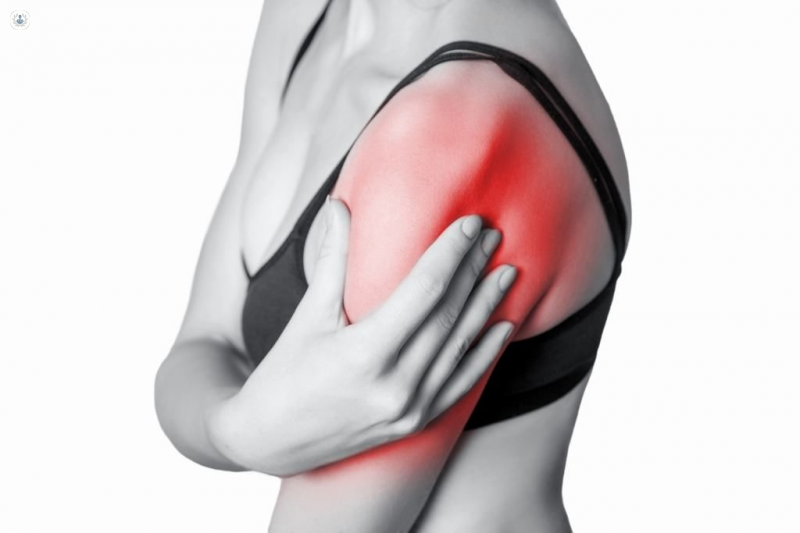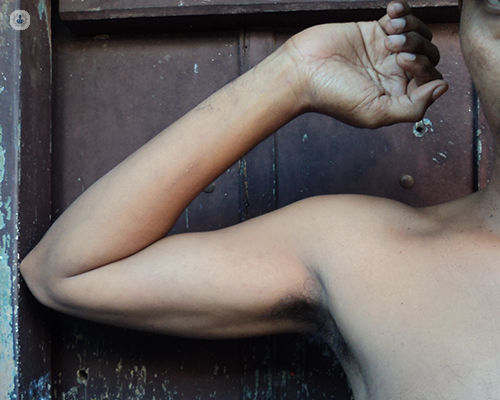Fractured humerus
Mr Simond Jagernauth - Orthopaedic surgery
Created on: 11-13-2012
Updated on: 04-24-2023
Edited by: Conor Lynch
What is a fractured humerus?
The humerus is the longest bone in the arm. It is articulated with the scapula by the shoulder, the ulna, and the radius in the elbow joint. The most common injury of this bone is a humerus fracture. This mainly affects the elderly and young people. Humerus fractures can be classified by the area affected: the upper, centre, or lower section.

What is the prognosis of a fractured humerus?
Recovery will depend on the following criteria:
- patient's age: if over 45 years of age, the risk of abduction limitation increases
- level of muscle contusion (bruising), especially the deltoid muscle
- shoulder muscle strength
- obesity
- level of patient cooperation and understanding
There are other factors that can slow down recovery. These include:
- inadequate rehabilitation
- insufficient muscle development
- bone tearing with fragment displacement
- taking too long to get the correct diagnosis
What are the symptoms?
Humerus fracture symptoms tend to be immediately noticeable, as there is often a loud snap or crack which is often an indication that the arm is fractured. There are other symptoms, including:
- severe pain that increases with arm movement
- swelling
- haematomas
- deformity of the arm or wrist
- inability to rotate the arm
If the patient is in a lot of pain and cannot use their arm, medical help should be sought as soon as possible. Delaying diagnosis and treatment can lead to poor healing.
How is a fractured humerus diagnosed?
X-rays are used to diagnose humerus fractures. This can help determine the extent of the injury, locate the exact location of the fracture, and see if it has affected a nearby joint. The doctor may order a CT scan in order to get a more detailed image.

How can it be prevented?
There are certain sports and conditions that can increase the risk of fracturing the humerus. These include; basketball, rugby, wrestling, football, hockey, snowboarding, or skiing. Osteoporosis, a condition that weakens the bones, or a fall, even from a short distance, can also cause a humerus fracture.
How is a fractured humerus treated?
There are different treatments for a humerus fracture. The specific one used will depend on the type of fracture. Treatments include:
- Bone adjustment: if the patient has a displaced fracture, the specialist will have to manipulate different parts of the humerus to ensure that it is in the right place. The patient may need a muscle relaxant, a sedative, or even general anaesthetic if the pain and swelling become unbearable.
- Immobilisation: the patient may need to use a sling, splint, brace, or plaster cast to immobilise the broken bone and ensure it is healing. Immobilisation time may vary, but it tends to be between 3 to 20 weeks.
- Medications: the specialist may prescribe painkillers to help with the pain and swelling.
- Physical therapy: it is important to start movement rehabilitation to minimise arm, hand, and shoulder stiffness while the arm is still in a cast or sling. Once these have been taken off, the specialist will recommend exercises to regain muscle strength, joint movement, and flexibility.
- Surgery: in some cases, surgery is needed to stabilise fractures. Fixation devices such as wires, plates, nails, or screws may be needed to maintain proper bone position during healing. The risk for complications is low, but there could be an infection and lack of bone healing.
Which specialist should I see?
A traumatologist, or orthopaedic specialist treats humerus fractures.
What should I do before I get my injury examined by a doctor?
If a patient suspects that they have suffered a fractured humerus, they should go to A&E as soon as possible. If they cannot be seen immediately, however, patients should be mindful of the following things that they should do before being seen:
- applying ice
- keeping the arm as still as possible
- avoiding eating or drinking just in case the patient needs to undergo immediate surgery
What complications are associated with a fractured humerus?
There are two main complications associated with a fractured humerus. These are:
- Radial nerve damage which can lead to numbness
- Nonunion (permanent failure of healing of a broken bone)
How long does a fractured humerus take to heal?
The exact period of time that a fractured humerus takes to heal depends entirely on the severity of the injury and how the patient responded to initial treatment. Fractured humerus recovery time, in some cases, can take up to 12 months in total if the patient suffered a severe injury to their arm.
Having said that, the patient's bones should knit in a time period of anywhere between six to eight weeks following treatment or surgery providing no complications have occurred during the healing period. In the majority of cases, a young person would typically regain full function in an affected arm after roughly three months.
